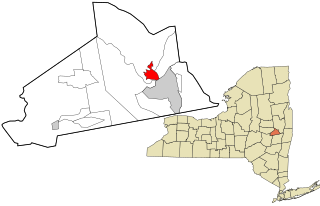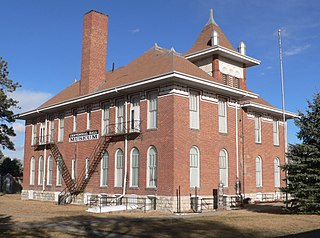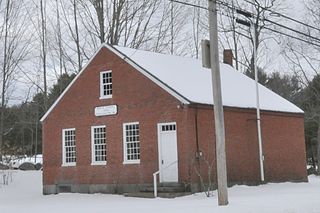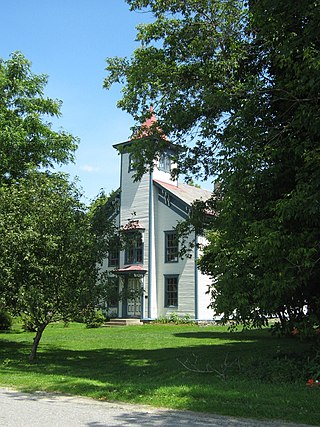
Glenvil is a village in Clay County, Nebraska, United States. The settlement has formerly also been known as Glenville. The population was 267 at the 2020 census. It is part of the Hastings, Nebraska Micropolitan Statistical Area.

Scotia is a village in Schenectady County, New York, United States, incorporated in 1904. The population was 7,729 at the 2010 census. Scotia is part of the town of Glenville, and is connected with the city of Schenectady by the Western Gateway Bridge over the Mohawk River.

The Old Dillard High School, also known as the Colored School or Walker Elementary, is a historic school in Fort Lauderdale, Florida. It is located at 1001 Northwest 4th Street. The first school building in Broward County for black students, it was built in 1924 by Cayot & Hart and the architect was John Morris Peterman. On February 20, 1991, it was added to the U.S. National Register of Historic Places. It is the oldest surviving black school in Fort Lauderdale, and is named for black education advocate James H. Dillard. Its first principal, from 1924 until 1937, was Joseph A. Ely. Clarence C. Walker, Sr. served as principal from 1937 until his death in 1942.

Glenville Historic District, also known as Sherwood's Bridge, is a 33.9 acres (13.7 ha) historic district in the Glenville neighborhood of the town of Greenwich, Connecticut. It is the "most comprehensive example of a New England mill village within the Town of Greenwich". It "is also historically significant as one of the town's major staging areas of immigrants, predominantly Irish in the 19th century and Polish in the 20th century" and remains "the primary settlement of Poles in the town". Further, "[t]he district is architecturally significant because it contains two elaborate examples of mill construction, designed in the Romanesque Revival and a transitional Stick-style/Queen Anne; an excellent example of a Georgian Revival school; and notable examples of domestic and commercial architecture, including a Queen Anne mansion and an Italianate store building."

The East Irvington School, or East Irvington Public School, is a former school building that served the neighborhood of that name in the town of Greenburgh, New York, United States as part of the Irvington School District. It was built in 1891 to educate the children of a growing population of Irish American laborers, and was expanded in 1925. The building continued to be used as a school until 1972. The brick building on Mountain Lane, with a rear entrance on Taxter Road, has since been converted to a condominium, but remains the oldest standing school building in the area. It was added to the National Register of Historic Places in 1983.

The Old Brick Church is a historic church building off Vermont Route 35 in Athens, Vermont. Built in 1817, it is a modest Federal style brick structure that served as a church and civic center into the 20th century. Architecturally it represents a transitional period, built with the furnishings of a typical 18th-century New England colonial meeting house, arranged on the long axis as was typical of 19th-century churches. It is now owned by the town, and was listed on the National Register of Historic Places in 1979.

The Glenville School is a historic school building at 449 Pemberwick Road in the Glenville section of Greenwich, Connecticut, United States. It was listed on the National Register of Historic Places in 2003. It was one of several schools built in the town in the 1920s, when it consolidated its former rural school districts into a modern school system, with modern buildings.

Defer Elementary School is a school building located at 15425 Kercheval in Grosse Pointe Park, Michigan in Metro Detroit. It was designated a Michigan State Historic Site in 1996 and listed on the National Register of Historic Places in 2001. A part of the Grosse Pointe Public School System, it serves much of Grosse Pointe Park.

The New Mill and Depot Building of the former Hawthorne Woolen Mill are located in Greenwich, Connecticut, United States. The two structures were built on an existing textile mill complex in the 1870s.

Strang School District No. 36, or the Strang Public School, is a historic school located in Fillmore County, Nebraska, in the village of Strang. The school is one of the two sites listed on the National Register of Historic Places in the village of Strang. The school building is a small, two-story, brick public schoolhouse, which was built to replace the schoolhouse that was previously located on that site. The schoolhouse was built between 1929 and 1930, and replaced the previous schoolhouse, which burned down in 1928. The schoolhouse still retains all original building materials. The school served high school students from 1930 to 1951, and still functions as a school today, serving grades K–8. The NRHP listing also includes a flagpole located outside the schoolhouse, and five pieces of playground equipment.

The Valentine Public School, at 3rd and Macomb Sts. in Valentine, Nebraska, was built in 1897. It has also been known as Centennial Hall.

The Richmond Public Library is the public library of Richmond, New Hampshire, United States. It is located in the Richmond School House No. 6 at 19 Winchester Road in the village center. Built in 1850, the building is the best-preserved of the town's few surviving district schoolhouses. It was listed on the National Register of Historic Places in 1980.

The North School, also known locally as the Brick School, is a historic one-room schoolhouse at 63 Amesbury Street in Kensington, New Hampshire, United States. Built in 1842, it was the only brick schoolhouse built in the town, and is one of its four surviving 19th-century schools. Of those, it is the best-preserved, and is used as a local history museum. It served the town's educational purposes between 1842 and 1956, and is now a local history museum. The building was listed on the National Register of Historic Places in 2013.
Glenville District No. 5 Schoolhouse, also known as Green Corners School, is a historic one-room school building located at Glenville, Schenectady County, New York. It was built about 1825, and is a small one-story, rectangular brick building. It measures approximately 24 feet by 20 feet. It rests on a stone foundation and is surmounted by a gable roof with overhanging eaves. It functioned as a public school for first through eighth grades until it closed in 1946. The building was restored in 1976.

The Ludlow Graded School is a historic former school building at 10 High Street in the village of Ludlow, Vermont. Built in 1871–72, the school was for many years the primary school feeding the adjacent Black River Academy. The building now serves as a local senior services center. It was listed on the National Register of Historic Places in 1979.

The Jonesville Academy is a historic school building at Cochran and Duxbury Roads in Richmond, Vermont. Built about 1868, it is a prominent local example of Italianate school architecture, and was used as a school until 1955. It is now in private ownership as a residence. It was listed on the National Register of Historic Places in 1982.

The Woodbury Graded School is a historic school building located at 63 Valley Lake Road in Woodbury, Vermont. Built in 1914, it is a prominent local example of Colonial Revival architecture, and of a period grade school. The building continues to serve its original purpose, now called the Woodbury Elementary School, and was listed on the National Register of Historic Places in 1993.

The Richland Historic District is a commercial and residential historic district located in the center of Richland, Michigan, containing structures near the intersection of 32nd Street, D Avenue, and Gull Road. The district was listed on the National Register of Historic Places in 1997.

A two-room schoolhouse is a larger version of the one-room schoolhouse, with many of the same characteristics, providing the facility for primary and secondary education in a small community or rural area. While providing the same function as a contemporary primary school or secondary school building, a small multi-room school house is more similar to a one-room schoolhouse, both being architecturally very simple structures. While once very common in rural areas of many countries, one and two-room schools have largely been replaced although some are still operating. Having a second classroom allowed for two teachers to operate at the school, serving a larger number of schoolchildren and/or more grade levels. Architecturally, they could be slightly more complex, but were still usually very simple. In some areas, a two-room school indicated the village or town was more prosperous.



















